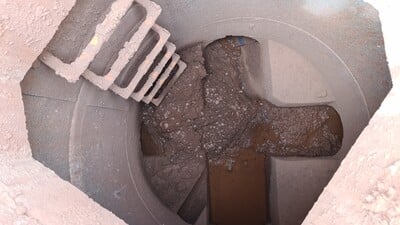The Hidden Dangers of Working in Manholes
Working in confined spaces like manholes is inherently risky. These environments often harbour noxious gases and fumes that can accumulate to dangerous levels, creating life-threatening conditions for workers. Unfortunately, incidents continue to occur, leading to serious injuries or fatalities.
For example, the fining of an NHS trust highlighted the dangers when a manhole worker was injured due to inadequate safety measures.
Elsewhere, a lack of respiratory protection in a confined space tragically claimed two lives, emphasising the severe consequences of failing to address these hazards.
Such incidents underscore the need for comprehensive safety procedures, particularly in monitoring air quality.
Why Monitoring Air Quality is Essential
Confined spaces such as drainage manholes can become a breeding ground for toxic gases, including hydrogen sulphide, methane and carbon monoxide. These gases are often odourless, colourless and heavier than air, settling undetected unless proper monitoring equipment is used.
Consequences of Poor Air Quality in Confined Spaces
Poor air quality in confined spaces is a significant issue, impacting health, safety and productivity. The risks associated with limited airflow and air contamination should not be underestimated.
Immediate and Long-term Health Risks
Exposure to toxic gases can cause headaches, nausea, respiratory distress, or even unconsciousness and death.
Short-term Effects
- Headaches and Dizziness: Lack of oxygen or high levels of carbon dioxide can quickly cause discomfort and confusion.
- Irritation of Eyes, Nose, and Throat: Pollutants like dust, chemical vapours, and fumes can lead to immediate irritation.
- Fatigue: Poor air quality can reduce oxygen supply to the brain and muscles, leading to sluggishness.
Long-term Effects
- Respiratory Illnesses: Prolonged exposure to harmful particles like asbestos or mould can lead to chronic bronchitis, asthma, or even lung cancer.
- Neurological Damage: Toxic gases such as carbon monoxide can cause long-lasting damage to the brain and nervous system.
- Cardiovascular Issues: Pollutants like fine particulate matter (PM2.5) are linked to heart diseases and increased risk of strokes.
Safety Risks in Confined Spaces
Poor air quality can also compromise safety by:
- Increasing the Risk of Fires or Explosions: Combustible gases like methane or hydrogen sulphide can accumulate, creating dangerous conditions.
- Causing Impaired Decision-making: Low oxygen levels or exposure to toxic gases can lead to confusion and slow reaction times, especially during emergencies.
Economic and Operational Consequences
Reduced Productivity
Workers in poorly ventilated environments are less efficient, as fatigue and discomfort hinder performance.
Higher Costs
Poor air quality can lead to:
- Increased absenteeism due to health issues.
- Equipment damage from corrosive pollutants.
- Regulatory fines for failing to meet health and safety standards.
Legal Responsibilities for Employers
UK employers are legally bound to ensure the safety of workers under the Health and Safety at Work Act 1974 and the Confined Spaces Regulations 1997. Key responsibilities include:
- Risk Assessments: Identifying hazards before work begins.
- Provision of Equipment: Supplying PPE and air monitoring devices.
- Training: Ensuring workers understand how to use safety equipment and recognise risks.
Failure to comply can lead to severe penalties and, more importantly, loss of life.
Types of Air Quality Monitors
The right equipment can mean the difference between life and death in confined spaces. Here’s an overview of the types of monitors available:
1. Single-Gas Detectors
- Designed to detect a specific gas, such as carbon monoxide or hydrogen sulphide.
- Compact and easy to use, ideal for targeted monitoring.
2. Multi-Gas Detectors
- Capable of detecting multiple gases simultaneously.
- Often include alarms that trigger when gas levels exceed safe thresholds.
3. Fixed Gas Monitors
- Installed at worksites for continuous monitoring.
- Provide real-time data, ideal for high-risk locations with frequent activity.
4. Personal Air Monitors
- Worn by individual workers to monitor their immediate environment.
- Lightweight and equipped with audible or visual alarms for instant alerts.
How Air Quality Monitors Work
Air quality monitors use advanced sensors to detect hazardous gas levels in the environment. Once gas concentrations reach unsafe levels, these devices trigger alarms through sound, light, or vibration, giving workers time to evacuate. Modern models may also offer:
- Data Logging: Recording gas exposure levels for analysis.
- Bluetooth Connectivity: Linking to smartphones for real-time updates.
- Pre-Calibrated Sensors: Simplifying maintenance and ensuring accuracy.
Prioritising Worker Safety
Investing in proper air quality monitoring and training is not just a regulatory obligation but a moral imperative. Employers must stay proactive, ensuring their teams are equipped with the tools and knowledge to stay safe in confined spaces.
We hope you have found this information helpful and interesting. If you have any further questions you are always welcome to call our friendly team of experts on 01420 555600 or email [email protected].
Also, look out for more articles in our ongoing series of blog posts, bringing you useful information, insights, guides and tips on all things drainage!

Written by
Bob Stone
Technical Sales
Heading up our Technical Estimating Department, Bob is our in-house quantity surveyor.

